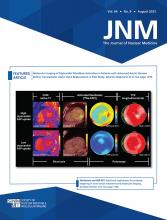Discussions with leaders: Jadvar talks with Carolyn C. Meltzer, MD, Dean of the University of Southern California Keck School of Medicine, about her career in academic radiology and institutional leadership.
Page 1167
PET Braak staging in AD: Macedo and colleagues summarize current efforts to implement Braak staging of Alzheimer disease using PET and assess correspondence between Braak histopathologic descriptions and PET AD biomarkers.
Page 1171
Tracking environmental pollutants: Delaney and colleagues focus on the potential roles of molecular imaging and radiochemistry in characterizing the pharmacokinetic profiles of pollutants at environmentally relevant doses.
Page 1179
SSTR PET in meningioma: Milosevic and colleagues report on institutional experience with somatostatin receptor–targeted [68Ga]-DOTATOC PET/MRI in suspected or diagnosed meningiomas and compare results with those from conventional MRI.
Page 1185
SUVmax and CUP: Zaun and colleagues identify an SUVmax threshold on 18F-FDG PET/CT imaging as a favorable prognostic factor at initial diagnostic workup in patients with cancer of unknown primary.
Page 1191
Metformin and membrane HER: Panikar and colleagues use human epidermal growth factor receptor–targeted PET to study antibody–tumor binding in mice treated with metformin, with implications for both cancer imaging and therapy.
Page 1195
Host–guest chemistry and pretargeted PET: Jallinoja and colleagues describe a cucurbituril host and adamantane guest molecule pairing for antibody-based pretargeted PET in both in vitro and preclinical studies.
Page 1203
68Ga-FAPI-RGD PET: Zhao and colleagues evaluate the clinical cancer imaging characteristics of a 68Ga-labeled heterodimer recognizing both fibroblast-activation protein and integrin αvβ3.
Page 1210
Oncologic FAPI PET/CT: Wass and colleagues provide a systematic review and metaanalysis to assess the diagnostic performance of fibroblast-activation protein inhibitor PET/CT in comparison with [18F]FDG PET/CT.
Page 1218
[18F]FAPI-74 oncologic PET: Watabe and colleagues detail the diagnostic performance of [18F]-labeled fibroblast-activation protein inhibitor-74 PET in patients with various histopathologically confirmed cancers or suspected malignancies.
Page 1225
[68Ga]FAPI-46 PET in pancreatic tumors: Rasinski and colleagues assess the diagnostic accuracy of [68Ga]-fibroblast activation protein inhibitor-46 PET/CT in pancreatic cancer and look at data needed to verify that this technique improves characterization of equivocal lesions.
Page 1232
PSMA PET/CT in unfavorable PCa: Hagens and colleagues determine the diagnostic value of PSMA PET/CT in staging men with newly diagnosed and unfavorable intermediate-risk prostate cancer.
Page 1238
[177Lu]-PSMA RLT in elderly patients: Tauber and colleagues analyze the efficacy and safety of PSMA radioligand therapy in octogenarian patients with metastatic castration-resistant prostate cancer, including data on response and toxicity rates and on predictors of survival.
Page 1244
TheraP PSMA PET eligibility criteria: Karimzadeh and colleagues evaluate outcomes for patients with metastatic castration-resistant prostate cancer treated with PSMA radioligand therapy, focusing on comparisons with TheraP and TheraP-based PET inclusion criteria.
Page 1252
Reader agreement VISION substudy: Kuo and colleagues research interreader variability and intrareader reproducibility of visual assessments of 68Ga-PSMA-11 PET/CT scans using the VISION trial read criteria, looking at agreement with VISION study results.
Page 1259
177Lu-PSMA RLT in treatment-naïve mCRPC: Satapathy and colleagues explore the impact of prior taxane chemotherapy on response and survival outcomes after [177Lu]Lu-PSMA radioligand therapy in patients with metastatic castration-resistant prostate cancer.
Page 1266
BMI and overall survival in PSMA RLT: Hartrampf and colleagues investigate fat-related and body composition parameters in patients undergoing PSMA-directed radioligand therapy to assess associated predictive values for overall survival.
Page 1272
Fibroblast activation in TAVR candidates: Diekmann and colleagues use multimodal imaging, including 68Ga-fibroblast activation protein inhibitor-46 PET, to determine the extent and functional correlates of myocardial fibroblast activation in patients with aortic stenosis scheduled for transcatheter aortic valve replacement.
Page 1279
PET/CT in hyperglycemia and infection: Pijl and colleagues describe the effects of blood glucose levels on the performance of 18F-FDG PET/CT for detecting infection foci in patients with bacteremia.
Page 1287
Comparative evaluation of MIRDcalc: Carter and colleagues report on validation of this internal dosimetry software and provide a compendium of radiopharmaceutical dose coefficients obtained with MIRDcalc.
Page 1295
Facial anonymization and total-body PET: Selfridge and colleagues detail development of a workflow that obscures a subject’s face in 3-dimensional volumetric data, with validation in total-body PET/CT imaging.
Page 1304
PET and opioid release after orgasm: Jern and colleagues use [11C]carfentanil PET and PET/MRI to test the hypothesis that sexual arousal peaking in orgasm leads to endogenous opioid release in men.
Page 1310
[18F]FASu and [18F]FSPG: Colovic and colleagues report on a comparison of these amino acid radiopharmaceuticals targeting system  , a PET biomarker for oxidative stress, including uptake specificity and ability to image glioma and lung cancer xenografts in vivo.
, a PET biomarker for oxidative stress, including uptake specificity and ability to image glioma and lung cancer xenografts in vivo.
Page 1314
161Tb-PSMA SPECT/CT: Al-Ibraheem and colleagues present whole-body scintigraphic and SPECT/CT images acquired with this promising agent in a case of metastatic prostate cancer refractory to hormonal therapy and chemotherapy referred for PSMA radioligand treatment.
Page 1322
- © 2023 by the Society of Nuclear Medicine and Molecular Imaging.







